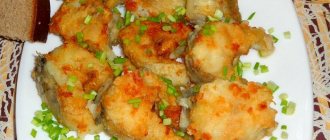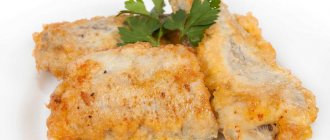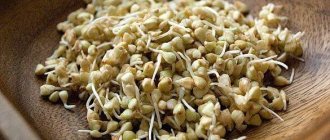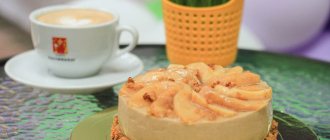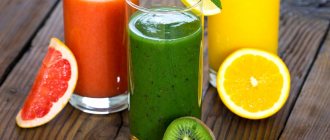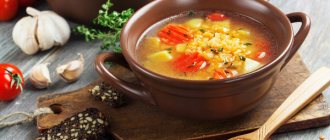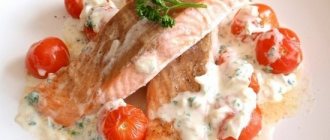Quick answer: the calorie content of boiled pollock is 79 kcal per 100 grams of product. See below for the energy value of fish in other cooking options.
This representative of the cod family is not as popular among chefs as its older brother cod, and in vain! The calorie content of pollock is really very low. And in terms of taste and nutritional qualities, it can give odds to many other types of fish.
Composition, calorie content and nutritional value
Depending on the cooking method, the composition, calorie content and nutritional value of pollock may vary.
Calorie content
The calorie content of raw fillet is 72.3 kcal per 100 g. If we subject the fish to heat treatment, we get:
- pollock fried in a frying pan – 275.9 kcal;
- steamed – 77.9 kcal;
- boiled – 74.1 kcal;
- stewed – 70.8 kcal;
- dried – 221.6 kcal;
- baked in the oven - 85.6 kcal.
Pollock caviar per 100 g has a calorie content of 133.1 kcal, and liver - 473.8 kcal. Milk – 91.2 kcal per 100 g. People who want to lose weight should give preference to boiled or steamed fish.
The nutritional value
Nutritional value of fish per 100 g:
- proteins – 16.1 g;
- carbohydrates – 0 g;
- fats – 0.8 g;
- water – 82.8 g;
- dietary fiber – 0 g.
BJU
Composition of pollock BZHU per 100 g of by-products:
| Product | Proteins, g | Carbohydrates, g | Fats, g |
| Pollock caviar | 26,8 | 1,2 | 1,9 |
| Pollock liver | 6,1 | 0 | 51,1 |
| Pollock milk | 15,88 | 0 | 2,9 |
From the table it becomes clear why the calorie content of fish liver is so high, but do not forget that the fats contained in fish will be useful only if consumed in moderation.
Compound
Chemical composition of pollock per 100 g:
| Name of substance | Unit | Contents in the product |
| Iodine | mg | 0,15 |
| Iron | mg | 0,81 |
| Fluorine | mg | 0,69 |
| Manganese | mg | 0,11 |
| Molybdenum | mcg | 3,97 |
| Copper | mcg | 129,1 |
| Chromium | mg | 0,55 |
| Vitamin A | mcg | 9,87 |
| Vitamin C | mg | 0,52 |
| Thiamine | mg | 0,11 |
| Vitamin PP | mg | 4,62 |
| Vitamin B9 | mcg | 4,75 |
| Potassium | mg | 415,9 |
| Phosphorus | mg | 239,6 |
| Sulfur | mg | 55,1 |
| Calcium | mg | 38,9 |
| Magnesium | mg | 55,7 |
In addition to the above elements, pollock contains omega-6 and omega-3 fatty acids, monounsaturated acids, as well as essential and nonessential amino acids necessary for the body to function properly.
Pollock calorie content per 100 grams of product for an ideal figure
Quick answer: the calorie content of boiled pollock is 79 kcal per 100 grams of product. See below for the energy value of fish in other cooking options.
This representative of the cod family is not as popular among chefs as its older brother cod, and in vain! The calorie content of pollock is really very low. And in terms of taste and nutritional qualities, it can give odds to many other types of fish.
Useful properties of pollock
With moderate consumption, pollock will become a beneficial product for the body:
- Thanks to the nutrients included in the product, the body stops the spread of inflammatory processes in internal organs, mucous membranes and skin.
- For smokers, pollock will be a particularly indispensable product, since thanks to its rich set of useful substances, the effects of nicotine on the lungs are blocked.
- Regular use of the product speeds up metabolism, prevents disorders of the nervous system, reducing the negative impact of stress on health.
- The product lowers cholesterol levels and thereby prevents the development of diseases such as atherosclerosis.
- Due to the presence of potassium in the composition, excess fluid is removed from the body, as a result of which swelling goes away.
- Pollock fillet is especially useful for people suffering from heart disease or at risk. Useful elements strengthen blood vessels and stabilize heart rate. The product is recommended for use for the prevention of diseases of the cardiovascular system - this is important for people who are constantly exposed to increased physical activity.
- Fish contains a lot of iodine, which improves the functioning of the thyroid gland. In addition, a sufficient level of iodine in the human body will increase vitality and improve overall well-being.
- Regular consumption of fish will strengthen the immune system and increase the body's defense against infectious diseases.
- Thanks to its high protein content, pollock helps athletes build muscle mass and restore strength after training.
According to some studies, sea fish, when consumed regularly, reduces the risk of cancer.
Benefits of pollock liver
The benefits of pollock liver are especially noticeable in the postoperative period - the products contain an increased concentration of fatty acids, which restore strength and increase vitality. In addition, the product has a positive effect:
- on metabolism in the body;
- functioning of the reproductive system;
- vision;
- condition of teeth, bones and nails;
- thyroid function;
- the functioning of the hematopoietic system;
- cardiovascular system.
In addition, it is useful to eat liver in winter, when the body suffers from vitamin deficiency.
The benefits of fish caviar
The composition of the product is rich in folic acid, vitamins B and E, as well as phosphorus, potassium, calcium and magnesium. The product not only has a positive effect on the functioning of internal organs, but is also used by women for cosmetic purposes.
Caviar affects the body in the form of:
- improving the functioning of the respiratory system;
- rapid recovery of strength after a serious or prolonged illness;
- providing the body with missing macro- and microelements, as well as vitamins.
As a cosmetic product, caviar is used to make face masks, which rejuvenates the skin and makes it more elastic. However, salted caviar is not suitable for the procedure and does not provide any particular benefit, just like fried caviar.
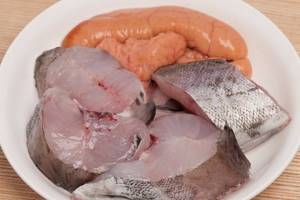
© moonrise — stock.adobe.com
Biological characteristics
Content:
- Biological characteristics
- The nutritional value
- Beneficial features
- Important Components
- Who needs pollock
- How to choose the right pollock
- Why is this fish dangerous?
- What to cook from pollock
- Surimi at home
Pollock is one of the most important bottom fish for the industry. In the fishery it ranks second after the Peruvian anchovy. Belongs to the cod family, like other representatives of this genus, has 3 dorsal fins and mustache. You can recognize this inhabitant of the seas by its olive-green belly and splashes on its body, large eyes and protruding lower jaw. An adult fish can reach 30-90 cm and weigh from half a kilogram to 800 g. It thrives both in shallow water and at depths of up to 200 m, although during the day it usually moves between the seabed and the surface of the water. Natural habitat is the cold waters of the North Pacific Ocean. Large catches of this fish can be expected along the western coast of America and the eastern coast of Asia. During the spawning period, when schools of fish swim close to the shore, it is easy to catch even with a fishing rod. It is important that if it is caught in the bays of Alaska, near the Aleutian Islands, or in the waters of the Bering Sea, you do not have to worry about the fish being contaminated with mercury or other chemicals. By origin, pollock can be Russian or from Alaskan waters. Russia's fishing industry is concentrated in the Sea of Okhotsk and Bering Sea.
This relatively fast-growing fish feeds on crustaceans, krill and other small sea creatures. The average life expectancy is up to 17 years, but fishermen value 3-4-year-old carcasses most of all. During the mating season, female pollock are especially interesting for their eggs. But despite this, pollock is not an endangered species. And the main reason is that it reproduces very quickly. In a few days, female pollock lay hundreds of thousands of eggs, from which from 100 thousand to a million offspring are born after 9-28 days.
In the period before spawning, the meat of this fish is valued, from which, in addition to fillets, they make fish sticks and surimi - an imitation of crab meat.
Impact on the body
Pollock has a healing effect on the body of both men and women:
- Systematic use of the product will remove heavy metals, breakdown products and toxins from the body.
- Fish improves the functioning of the musculoskeletal system and prevents tooth decay.
- By eating pollock regularly, you help your visual organs. The product reduces eye strain and prevents the development of eye diseases. All this is possible thanks to the vitamin A included in the composition.
- Pollock lowers blood sugar levels, which serves to prevent the development of diabetes, as well as an auxiliary component in the treatment of the disease.
- Eating fish at least a couple of times a week will improve the maturation of blood cells.
- The product perfectly helps to restore strength after a serious illness or physical exertion, as well as activities associated with increased brain activity.
- Thanks to the nutrient-rich composition of the product, brain function improves, concentration and attentiveness increase. In addition, pollock has a positive effect on memory.
- Fish has a beneficial effect on the reproductive system in both men and women, increases potency and increases the likelihood of conception.
- The beneficial substances included in the product improve the condition of nails and accelerate hair growth.
In addition to the above, pollock improves tissue regeneration, strengthens ligaments and cartilage tissue.

© sasazawa — stock.adobe.com
Pollock as an effective element of weight loss
Pollock is an ideal dietary product with low calorie content and a large selection of cooking methods that will not lose beneficial properties or increase calorie content.
To lose weight, it is better to steam fish, for example, in the form of cutlets, bake fillets in the oven, boil or stew without oil with vegetables or rice.
Due to the fact that fish consists of almost 100% proteins, which are absorbed by the body as quickly as possible, the functioning of the stomach and intestines improves, and metabolism accelerates. If you exercise at the same time, your muscle mass will increase, which will make your body more toned and strong.
To lose weight, you should not eat salted or fried pollock. In the first case, fluid will be retained in the body, which will lead to swelling and poor health, and in the second, the caloric content increases and all beneficial properties are completely destroyed.
Note: pollock liver, despite its high calorie content, can be eaten while losing weight, but in small portions.
Delicious dietary dishes
Experts say that it is best to cook pollock using the simplest, most accessible methods, which will only emphasize its pleasant taste and will not add calories.
The taste of the fish is a little dry, so most often housewives prefer to bake it in the oven or stew it with vegetables.
Baked pollock in spicy sauce
For example, for baked pollock in spicy sauce you will need:
- fish fillet - 700 g;
- walnuts - 100 g;
- pickled cucumbers - 2 pcs. (small);
- sour cream - 4 tbsp. l.;
- salt, pepper, fresh herbs - to taste;
- butter - 10 g.
This preparation:
- The fish must be processed, all bones removed, and the fillets cut into medium-sized pieces. The pollock prepared in this way is salted and peppered, then fried in a frying pan in a small amount of oil until golden brown.
- At the same time, the sauce is being prepared. To do this, walnuts, herbs, cucumbers, sour cream and spices are thoroughly ground in a blender.
- The fried fish is laid out on a baking sheet greased with butter and sauce is poured on top.
- The oven should be preheated to 200 degrees. Bake for 25 minutes.
Pollock with vegetables in egg batter
You can also bake pollock with vegetables in egg batter.
- To do this, you need to cut 600-700 grams of fillet into pieces and sprinkle with two tablespoons of lemon juice.
- Then place them in a greased pan.
- On top are three tomatoes cut into circles, sprinkle everything with parsley, salt and pepper. Pour in two beaten chicken eggs.
- Bake for 20-25 minutes in an oven preheated to 200 degrees.
Pollock baked with carrots and onions
For fish baked with carrots and onions, you need:
- pollock - 1 pc. (medium size);
- onion - 1 pc.;
- carrots - 1 pc.;
- sour cream - 50 g;
- salt and pepper - to taste.
Cut the fully processed fish into medium-sized pieces, add salt and pepper. Cut one onion into ring halves, grate the carrots on a coarse grater and place them in layers in a greased form. We put pollock on them.
Pour sour cream and 3-4 tablespoons of boiling water over the fish. Cover the baking dish with foil and place in an oven preheated to 200 degrees for 25-30 minutes.
Harmful effects
In case of abuse of fish, as well as individual intolerance to seafood or allergies, there is a risk of negative effects of the product on human health.
Contraindications for eating pollock:
- hypertension - this applies to fried or salted fish and caviar, which can increase blood pressure;
- aggravated form of gastrointestinal tract diseases;
- Pollock liver should be avoided if the digestive tract is inflamed;
- Pregnant women should not eat salted or dried fish, as it can aggravate swelling.
In addition, any seafood can accumulate heavy metals that are hazardous to health. For this reason, you should not eat pollock raw or overuse the product, as this can lead to mercury poisoning.
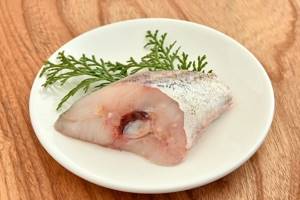
© kikisora — stock.adobe.com
conclusions
It turns out that if you want to eat well, but are worried about possible extra pounds on your body, then it would be nice to remember about a product that has returned to its popularity as a dietary product. This is pollock fish, the calorie content of which will have absolutely no effect on your waistline. Recently, due to complaints from visitors and supporters of healthy eating, the world famous McDonald's restaurant began to indicate calorie content on its dishes. So, it is precisely because of the low calorie content in pollock that this fish is used in the famous fillet-o-fish. In Japan, minced surimi is made from its fillet. So pollock is far from such a simple product.
